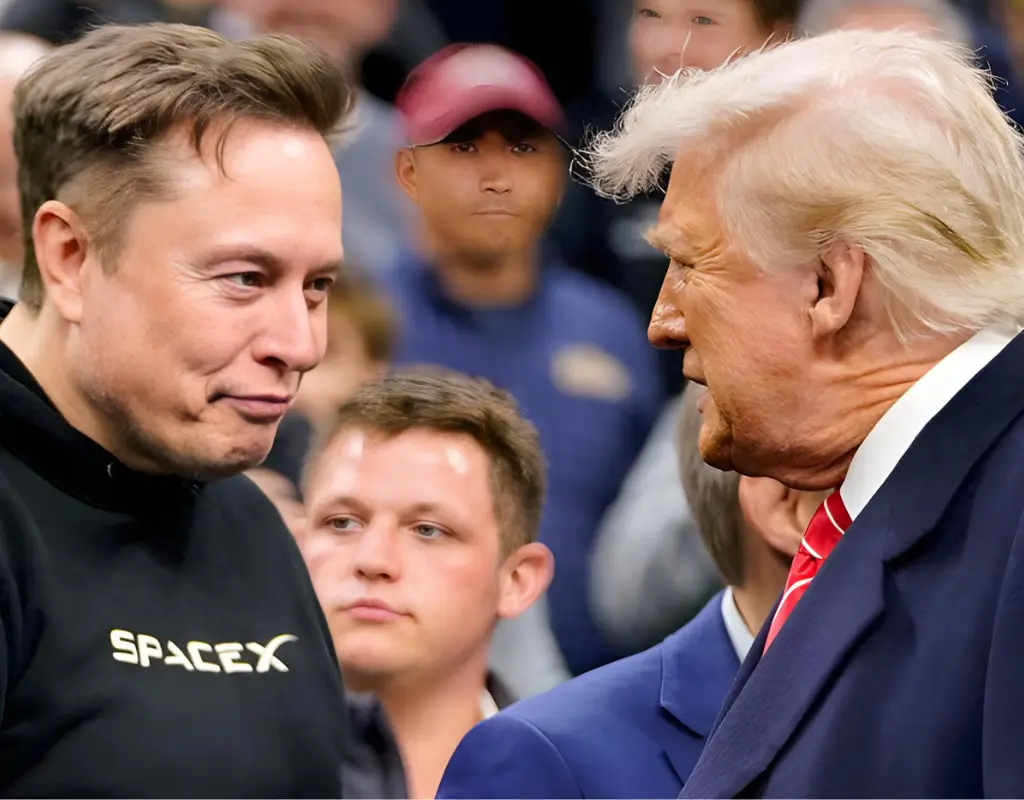Now Reading: Trump-Musk Feud: The Intense Public Rift of Mid-2025 Decoded
-
01
Trump-Musk Feud: The Intense Public Rift of Mid-2025 Decoded
Trump-Musk Feud: The Intense Public Rift of Mid-2025 Decoded

Unpack the intense Trump-Musk public feud of mid-2025. Discover what sparked their dramatic split and its far-reaching impact on politics and tech.
In the unpredictable theatre of modern American politics, few alliances captivated public imagination quite like the burgeoning relationship between U.S. President Donald Trump and tech visionary Elon Musk.
What began as an unlikely, yet strategically potent, partnership has, in the summer of 2025, dissolved into an extraordinary public feud, playing out in real-time across social media platforms and sending ripples through global markets and political landscapes.
This isn’t merely a clash of titans; it’s a profound examination of ego, influence, and the precarious interplay between immense wealth, political power, and public perception in the digital age.
This article delves into the intricate unraveling of the Trump-Musk alliance, dissecting the moments that led to their dramatic public split.

We will explore the initial foundations of their collaboration, the policy disagreements that ignited the conflict, the unprecedented social media escalation, and the far-reaching implications for both the Republican Party and the sectors heavily influenced by Musk’s ventures.
More critically, we will analyze how such high-profile disputes, amplified by social media, redefine the boundaries of political discourse and public accountability.
The Architect of Influence: How the Trump-Musk Alliance Took Shape
The relationship between Donald Trump and Elon Musk has always been dynamic, marked by periods of both public praise and sharp criticism.
However, following Trump’s successful 2024 presidential campaign and subsequent re-election, their alliance appeared to solidify in early 2025, marking a significant strategic partnership.
Musk, a self-proclaimed “free speech absolutist” and a vocal critic of what he often terms “government overreach” and “wokeness,” found common ground with the newly inaugurated President.
Their collaboration reached a visible peak when Musk was appointed to spearhead a newly created White House initiative: the Department of Government Efficiency, quickly and colloquially dubbed “DOGE.”
This was more than a symbolic gesture; for nearly five months, Musk reportedly held an office in the West Wing and participated in Cabinet meetings, signaling a tangible role in shaping the administration’s drive for bureaucratic streamlining and fiscal responsibility.
Trump, known for his appreciation of powerful figures and disruptive innovators, likely saw in Musk a valuable ally who could energize a segment of tech-forward voters and bring a business-centric approach to government.
For Musk, aligning with the presidency offered an unprecedented platform to influence policy directly, potentially benefiting his sprawling array of companies, from electric vehicles (Tesla) to space exploration (SpaceX) and artificial intelligence (xAI).
This period of apparent synergy, characterized by joint press conferences and public endorsements, projected an image of two formidable forces united by a shared vision of efficiency and American economic might.
The Fiscal Fault Line: “The Big, Beautiful Bill” Ignites the Conflict
The apparent harmony between Trump and Musk began to unravel with the introduction of the administration’s ambitious new tax and spending proposal, ironically dubbed “The Big, Beautiful Bill.”
This comprehensive legislative package, designed to reshape the nation’s economic landscape, quickly became a point of contention for many fiscal conservatives.
Projections from independent congressional budget offices indicated that the bill could add an estimated $2.4 trillion to the national debt over the next decade.
For Elon Musk, known for his outspoken views on fiscal prudence and concern over national debt, this bill represented a fundamental deviation from the fiscal conservatism he often champions.
His past public statements have consistently emphasized the importance of sound financial management for the nation’s long-term stability.
The proposed increase in national debt, particularly without clear offsetting measures, directly contradicted his stated principles.
On June 3, 2025, Musk transformed his frustration into a public outcry on X (formerly Twitter). His all-caps post declared:
“This bill is a disgusting abomination. K*LL the BILL! It was passed in the dead of night without proper review.”

This tweet was unprecedented in its directness and forcefulness, marking a clear and unmistakable break from his previous support for the administration’s broader agenda.
It signaled that policy disagreements, particularly those touching on deeply held economic principles, could supersede political alliances, no matter how influential.
A Digital Duel: Egos Clash on Social Media
Musk’s scathing criticism of “The Big, Beautiful Bill” swiftly provoked a characteristic counter-attack from President Trump, escalating the feud from a policy disagreement to a full-blown personal and political battle.
Trump leveraged his platform, Truth Social, to launch his retort, claiming, “Elon was wearing thin. I asked him to leave. I took away his EV mandate… and he just went CRAZY.”

This statement not only dismissed Musk’s concerns but also attempted to assert presidential authority over the tech magnate’s business interests, particularly in the electric vehicle sector, a cornerstone of Tesla’s success.
Refusing to be silenced, Musk escalated his digital counter-offensive. His response on X was a direct and stinging challenge to Trump’s political standing:
“Without me, Trump would have lost the election. Dems would control the House and the Republicans would be 51-49 in the Senate.”

This audacious claim, though impossible to definitively prove, underscored Musk’s perception of his own significant influence in the 2024 election cycle, where he was indeed a major political donor and active public voice.
He further rubbed salt in the wound by unearthing and reposting one of Trump’s own tweets from 2013, which criticized Republicans for increasing the national debt ceiling.
Musk’s succinct addition, “Wise words,” served as a pointed reminder of Trump’s past fiscal stances, highlighting what many observers saw as a policy inconsistency.
This rapid exchange laid bare the fundamental clash of two formidable egos accustomed to dominating their respective spheres. Both Trump and Musk thrive on direct communication and leverage social media as primary tools for public engagement and, when necessary, confrontation.
Their digital duel demonstrated the raw power of these platforms to shape narratives, ignite public debate, and redefine political alliances in real-time.
The Controversial Undercurrent: Unverified Accusations Enter the Fray
The feud took a highly controversial and ethically precarious turn when Elon Musk, in a series of posts on X, brought up the long-debunked and unverified claims related to financier Jeffrey Epstein.
In one widely noted post, Musk wrote: “Time to drop the really big…. @realDonaldTrump is in the Epstein files. That is the real reason they have not been made public. Have a nice day, DJT!”

It is crucial to emphasize that this claim, made by Elon Musk, lacks any official or verifiable evidence. Reputable legal experts and investigators have repeatedly stated that no official documentation or court proceedings have ever confirmed any wrongdoing by Donald Trump in relation to Jeffrey Epstein’s activities.
The U.S. Department of Justice and the Federal Bureau of Investigation have also concluded that Jeffrey Epstein died by suicide and that there was no evidence he maintained a “client list” of powerful figures involved in illegal activities, despite widespread conspiracy theories.
The inclusion of such unverified and potentially defamatory accusations by a public figure like Musk, even if later retracted or unproven, significantly raises the stakes of the feud.
It not only demonstrates the willingness of powerful individuals to employ highly inflammatory rhetoric but also highlights the challenges of navigating information in the digital age.
Media platforms and the public face a critical responsibility to distinguish between alleged statements made in a public spat and substantiated facts.
Legal experts have unequivocally warned that the dissemination of unverified material on matters as serious as this can lead to severe legal repercussions and contribute to widespread misinformation.
This incident underscored how quickly a political disagreement can devolve into personal attacks, leveraging unsubstantiated claims that, once introduced, become incredibly difficult to erase from the public consciousness, regardless of their veracity.
The Impeachment Tweet: A Line in the Sand
Perhaps the most astonishing development in the rapidly escalating feud came when Elon Musk responded with a single, affirmative word – “Yes” – to a user’s post suggesting that President Trump be impeached and replaced by Vice President JD Vance. This one-word reply, shared publicly on X, sent shockwaves across the political landscape.

Coming from someone who had been a significant supporter of Trump’s 2024 campaign and held a key advisory role within his administration, Musk’s “Yes” was interpreted as an unequivocal declaration of political opposition.
It moved beyond mere criticism of a specific bill or a personal spat; it directly challenged the legitimacy of the sitting President’s tenure and suggested a willingness to support the highest form of political censure.
This move was particularly jarring given Musk’s previous stance as an anti-establishment figure often critical of traditional political processes.
It ignited a frenzy of speculation about his motivations and the future of his relationship not just with Trump, but with the Republican Party establishment as a whole.
The Real-World Fallout: Billions, Boards, and Beyond

The ongoing public clash between Trump and Musk is far from mere online drama; it has tangible, significant real-world consequences that ripple through financial markets, corporate boardrooms, and even national infrastructure.
- Financial Impact: The immediate aftermath of Musk’s increasingly aggressive stance saw a notable decline in the value of his flagship company. Tesla’s stock reportedly dropped by approximately 14% in a single day, wiping an estimated $150 billion off its market capitalization.
- This directly impacted Musk’s personal wealth, with projections suggesting a loss of around $34 billion. Such volatility highlights how tightly intertwined political stability and market confidence can be, especially when key corporate leaders engage in highly public political disputes. Investors often react negatively to perceived distractions or conflicts that could jeopardize government relations or corporate focus.
- Government Contracts and National Security: Musk’s businesses, particularly SpaceX, rely heavily on lucrative government contracts, most notably with NASA and the Department of Defense. His hint at decommissioning key SpaceX programs, including the Dragon spacecraft which is vital for NASA’s missions to the International Space Station, sent immediate shockwaves through the space community. While he later clarified and walked back those comments, the mere suggestion underscored the vulnerability of critical national programs to the whims of powerful private individuals and their political alignments. Any disruption to SpaceX’s operations could have profound implications for U.S. space capabilities and national security.
- Political Realignments: The feud has forced a re-evaluation of allegiances within the Republican Party. Musk’s launch of a new political party, the “America Party,” in early July 2025, further exacerbated tensions. This move, stemming from his belief in breaking the “two-party (or uniparty) system” and his opposition to the “Big, Beautiful Bill,” poses a significant challenge to the GOP.
- A third-party movement, especially one funded and championed by a figure as influential as Musk, could fracture the Republican vote base, potentially impacting the crucial 2026 midterm elections and beyond. For Trump, the risk is losing control over a platform (X) and an influential voice that previously helped amplify his message.
- Corporate Governance and Investor Confidence: The intensity of Musk’s political engagement raises questions about his focus and commitment to his leadership roles at Tesla, SpaceX, and xAI. Reports of House Speaker Mike Johnson attempting to reach Musk, only for Musk to be too engrossed in tweeting to answer calls, fueled concerns about CEO distraction.
- Investors and corporate boards often prefer their leaders to focus primarily on business operations, and highly public, contentious political feuds can erode investor confidence and raise governance concerns.
The Digital Echo Chamber: How the Internet Reacts
The Trump-Musk fallout immediately became a viral phenomenon across social media platforms, transforming a high-stakes political clash into a spectacle of public commentary and humor. Memes, hashtags, and satirical content exploded, with users comparing the spat to reality television drama.
Jokes ranged from the absurd (“Liza Minnelli has outlived the Trump–Musk bromance”) to the darkly humorous (“Even fictional villains are asking them to calm down”).
This widespread internet reaction highlights several aspects of modern digital culture:
- The Spectacle of Power: The public is increasingly accustomed to consuming political and business news through the lens of personal drama and entertainment.
- Democratization of Commentary: Social media platforms allow anyone to become a commentator, leading to a cacophony of voices, from insightful analysis to purely speculative or comedic takes.
- Amplification of Conflict: The algorithms of these platforms often favor contentious content, inadvertently amplifying disputes and making it difficult to discern verified information from widespread rumor or satire.
- Blurring of Lines: The lines between politics, business, and entertainment blur significantly when such high-profile figures engage in public spats on platforms designed for casual interaction.
The incident also underscored how personal communication tools have become integral to the highest levels of power. The image of the Speaker of the House attempting to reach a key figure via text, only to be ignored for more public tweeting, is a testament to this new reality.
What Comes Next? The Shifting Sands of Power and Influence
As of mid-July 2025, the dust has yet to settle on the Trump-Musk feud. Rumors of potential private meetings to mend fences circulate, but whether reconciliation is truly possible, or if this marks a definitive, irreversible split, remains uncertain.
The implications of this unprecedented clash are profound and will undoubtedly shape the future trajectory of American politics and the intersection of technology and governance.
- Fractured Political Landscape: If Musk’s “America Party” gains significant traction, it could fundamentally alter the dynamics of the two-party system, potentially drawing support from disaffected Republicans and independent voters. This could have unpredictable consequences for future elections, particularly the 2026 midterms.
- The Role of Billionaires in Politics: The feud further emphasizes the outsized influence of billionaires in shaping political discourse and outcomes. It raises questions about the ethical boundaries of such influence and the potential for personal agendas to impact national policy and stability.
- Public Trust and Discourse: The use of unverified accusations and inflammatory rhetoric by powerful figures poses a challenge to public trust in institutions and the very fabric of political discourse. It underscores the need for media literacy and critical thinking among citizens to navigate an increasingly complex information environment.
- The Future of Tech and Government: The dispute could also impact how future administrations engage with Silicon Valley titans, potentially leading to more cautious or formal relationships, or conversely, even greater integration.
Watching two of the world’s most powerful and unconventional figures engage in such a public and contentious confrontation is both fascinating and unsettling.
It’s a real-time display of ego, influence, and the evolving nature of power in a hyper-connected world. Whether this marks a temporary storm or the beginning of a new, more volatile era of billionaire-fueled political chaos, one thing is clear: we are witnessing history in the making, and its full ramifications are yet to unfold.
Also read: You’re Already A Time Traveler! Mind-Blowing Ways Physics Proves Time Travel In 2025. – ParsoTak.in





















